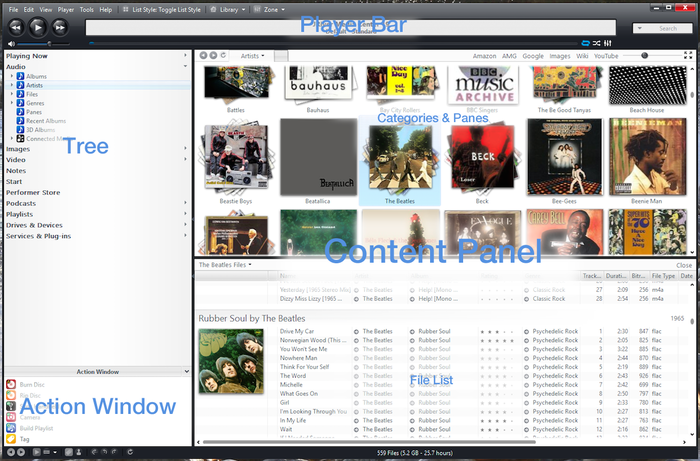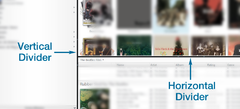Difference between revisions of "Standard View"
| (37 intermediate revisions by one other user not shown) | |||
| Line 1: | Line 1: | ||
| − | + | Standard View is one of the five primary [[View Modes]] of Media Center, and is the main interface that is used for basic navigation and operation of the application. It is designed to be used from a desktop computer with a mouse and keyboard, but you can control the size of the interface elements to make it work on touchscreen devices as well. This is where you will perform all of your [[setup]], [[Library Tools|media and metadata management]], access [[Media Views]], and all other functions of the application. Standard View is the "primary interface" of Media Center. | |
| − | + | == Sections == | |
It has four main sections which are arranged like so: | It has four main sections which are arranged like so: | ||
| Line 14: | Line 14: | ||
* [[Content Panel]] | * [[Content Panel]] | ||
| − | In most view types, the Content | + | In most view types, the Content Panel is itself composed of two separate sub-panels: |
* [[Categories and Panes]] | * [[Categories and Panes]] | ||
* [[File List]] | * [[File List]] | ||
| − | + | Please refer to the individual articles listed above for further information on using the various sections and components of Media Center's Standard View. | |
| − | + | == Divider Bars == | |
| − | + | [[File:Divider Bars-cropped.png|Divider Bars|thumb|right|240px]] | |
| − | + | {{See also|Divider Bars}} | |
| − | + | Standard View is divided into its sections by a set of two independent [[Divider Bar]] controls. These movable dividers are similar to those you may have seen in other applications. These bars can be dragged, from anywhere along its length, in order to resize the individual sections. Each bar also contains a set of arrows that can be clicked to completely hide the section, or restore it from a hidden position. | |
| − | |||
| − | |||
| − | |||
| − | + | * The vertical bar divides the [[Tree]] and [[Action Window]] on the left, and the [[Content Panel]] on the right. | |
| + | * The horizontal bar divides the sections of the [[Content Panel]]. It is only shown in views for which the Content Panel shows two sub-sections, as opposed to views with a header and file listing only (such as [[Playlists]] or [[Podcasts]]). When available, the horizontal bar divides the [[Categories and Panes]] on top, and the [[File Listing]] below. | ||
| − | + | == Toolbars == | |
| − | [[File: | + | {{See also|Toolbars}} |
| + | |||
| + | In addition, Standard View has customizable top and bottom toolbars, which can be used to "pin" buttons for a variety of useful functions. | ||
| + | |||
| + | [[File:Top Toolbar.png|thumb|none|800px|Media Center's top Toolbar on Windows, with a few custom buttons added.]] | ||
| + | [[File:Bottom Toolbar.png|thumb|none|800px|Media Center's bottom Toolbar on Windows, with a few custom buttons added.]] | ||
| + | |||
| + | The top toolbar contains the standard OS window controls (close, min, etc). On Windows, it also contains the File, Edit, View, and other drop-down menus (on the Mac version these are integrated into the OS menu bar). | ||
| + | |||
| + | The bottom Toolbar contains a flexible status display, which lists the number of files shown in any selected view, and other information about current processes in Media Center (such as background tagging operations). To these, you can add your own set of buttons that provide quick access to a variety of functions within MC. For more information on this, please refer to the [[Toolbars]] article. | ||
[[Category: Standard View]] | [[Category: Standard View]] | ||
[[Category: Frequently Asked Questions]] | [[Category: Frequently Asked Questions]] | ||
Latest revision as of 10:52, 17 June 2019
Standard View is one of the five primary View Modes of Media Center, and is the main interface that is used for basic navigation and operation of the application. It is designed to be used from a desktop computer with a mouse and keyboard, but you can control the size of the interface elements to make it work on touchscreen devices as well. This is where you will perform all of your setup, media and metadata management, access Media Views, and all other functions of the application. Standard View is the "primary interface" of Media Center.
Sections
It has four main sections which are arranged like so:
These are:
In most view types, the Content Panel is itself composed of two separate sub-panels:
Please refer to the individual articles listed above for further information on using the various sections and components of Media Center's Standard View.
Divider Bars
- See also: Divider Bars
Standard View is divided into its sections by a set of two independent Divider Bar controls. These movable dividers are similar to those you may have seen in other applications. These bars can be dragged, from anywhere along its length, in order to resize the individual sections. Each bar also contains a set of arrows that can be clicked to completely hide the section, or restore it from a hidden position.
- The vertical bar divides the Tree and Action Window on the left, and the Content Panel on the right.
- The horizontal bar divides the sections of the Content Panel. It is only shown in views for which the Content Panel shows two sub-sections, as opposed to views with a header and file listing only (such as Playlists or Podcasts). When available, the horizontal bar divides the Categories and Panes on top, and the File Listing below.
Toolbars
- See also: Toolbars
In addition, Standard View has customizable top and bottom toolbars, which can be used to "pin" buttons for a variety of useful functions.
The top toolbar contains the standard OS window controls (close, min, etc). On Windows, it also contains the File, Edit, View, and other drop-down menus (on the Mac version these are integrated into the OS menu bar).
The bottom Toolbar contains a flexible status display, which lists the number of files shown in any selected view, and other information about current processes in Media Center (such as background tagging operations). To these, you can add your own set of buttons that provide quick access to a variety of functions within MC. For more information on this, please refer to the Toolbars article.

